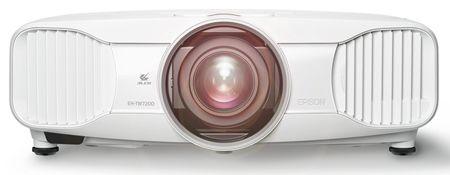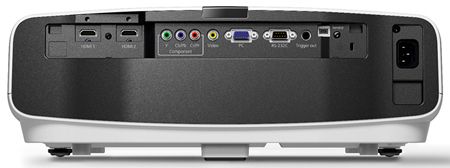Epson EH-TW7200

 This year, projection specialist Epson has rejigged its product lineup to target the bigscreen movie fan who wants to step up from a £1,000 model but isn't ready to enter the competitive mid-range market where Sony and JVC are also trading blows. The result is the EH-TW7200, its 'entry-level' 3D model that retails for approximately £1,900 – a price point that other brands often ignore.
This year, projection specialist Epson has rejigged its product lineup to target the bigscreen movie fan who wants to step up from a £1,000 model but isn't ready to enter the competitive mid-range market where Sony and JVC are also trading blows. The result is the EH-TW7200, its 'entry-level' 3D model that retails for approximately £1,900 – a price point that other brands often ignore.
Essentially this three-chip Full HD LCD design replaces last year's £2,300 EH-TW8100, but with some differences. Most notably, the handset – a nicely-designed zapper with good-sized buttons and switchable backlighting in tasteful green – totes a frame interpolation button (Frame Int), which, when pressed, rewards you with nothing more exciting than a 'this button can't be used' message. This, of course, is because Epson hasn't updated its handset design, and the EH-TW7200 has been stripped of frame interpolation. A pity, since Epson's tech has proved quite effective at reducing motion judder with some content.
The EH-TW7200 is physically quite large, which helps to disperse heat and reduce reliance on cooling fans. Indeed, it's very quiet in operation – certainly in the 'low power' mode that extends the claimed lamp life from 4,000 to 5,000 hours and improves blacks.
The excellent fundamental design of the TW7200 can also be found in the optical system, which is easy to set up and, better still, free of drift. On the top panel are wide-ranging lens-shift thumbwheels for accurately centering the projected picture on your screen. The lens itself incorporates a pair of rings for focusing and zoom; this all-important glassware is protected from dust by a motorised shutter when the PJ is turned off.
Thanks to Epson's well thought-out design, basic installation can be completed within minutes. A blue 'grid-and-circle' test-pattern generator is provided to help you register your image correctly.
There are four default 'color' (picture) modes, plus two more for 3D viewing. They can deliver stonkingly good results out of the box, 'cinema' being particularly praiseworthy. In its marketing, Epson places a lot of emphasis on colour; in particular, the use of 'colour light output' (CLO) – measuring the light output of primary colours, as opposed to traditional 'white-only' brightness – to spec projector performance.
While the presets may be good, that's not to say the odd tweak here and there doesn't help. Thankfully, the picture setup functions are driven from a comprehensive battery of menus. Basics like saturation, tint, contrast, skin-tone, colour temperature and sharpness are supplemented by an 'advanced' menu that lets you wrest control over gamma, RGB offset/gain (or RGBCMY) levels, white level, lamp brightness and auto-iris.
These settings can be saved to one of ten renameable memories for instant recall from the remote. Other buttons switch between the available input sources (which include two HDMI ports), toggle through the three aspect ratios and engage 'Super Resolution'. The latter, a fancy 2D-only sharpness boost, can highlight intricate areas. If it's wicked up too high, though, an unpleasant haloing artefact sets in – use it sparingly, if at all. Overall, the TW7200 is as easy to use as it is to configure.

A few recent episodes of The Simpsons (2D broadcast) demonstrated how well the TW7200 copes with bright colours, thereby going some way to justify Epson's CLO claims. They are perfectly registered too, with no bleed. LCD projectors have come far in the last decade; no longer are they a poor second to the DLP competition. I'd even go as far as to say that colours are more vibrant than those from some of the three-chip DLP projectors that were available not so long ago. Plenty of detail is buried in this iconic 'toon on closer inspection, and the TW7200 does justice to it.
Next up was The Wolverine (2D Blu-ray). This visually stunning movie is set in Japan, a country that happens to be wonderfully filmic – whether we're examining the subtle hues of a traditional building, or the complexity and pace of its unique urban sprawl. In the opening scenes, Logan (Hugh Jackman) saves soldier Yashida from the Nagasaki atomic bomb, and the resulting explosion is rendered with true-to-life realism as it spreads from the city to the prison-camp. The Epson combines a freedom from untoward motion artefacts with a wide colour palette and strong dynamics.
Indeed, the wide contrast range is evident later in the film. Following a bullet-train Yakuza-pursuit sequence, Logan and Yashida's granddaughter Mariko travel to a retreat in the same area of present-day Nagasaki. It's dusk, and the interior of the home is dimly-lit. Yet considerable shadow detail is visible, and the textures and colours of the wooden construction – together with the subtler flesh-tones – are accurately portrayed.
The auto-iris may work better than that built into some units, but some 'pumping' is visible on occasions; for this reason, I turned it off. Doing so impacts black levels slightly, but it's a price worth paying.
With 3D content, the light-attenuating properties of the glasses contribute to decent blacks (although the projector provides compensation). My 3D demo disc was Baz Luhrmann's realisation of The Great Gatsby. The TW7200 did a fine job handling the recreation of 'Jazz-Age' New York; sniffing out the stunning detail that grips your attention. Gatsby's lavish parties looked fantastic in 3D, as did the shots that zoomed across the water from his mansion to the Buchanan residence. The only real fly in the ointment is a perceptible degree of judder. And there's no smoothing mode to experiment with, remember...
Money well spentIn all honesty there's little to criticise here. The TW7200 represents a lot of projector for the money, and though it lacks the ISF calibration modes of its bigger brothers can nevertheless be tweaked to give a very fine picture indeed. An essential audition.
Specification
3D: Yes
4K: No. 1,920 x 1,080
Connections: Composite input; component input; VGA input; 2 x HDMI inputs; mini-USB service port; RS232; 12V trigger output
Brightness (claimed): 2,000 ANSI Lumens (CLO)
Contrast (claimed): 120,000:1
Dimensions: 466(w) x 140(h) x 395(d)mm
Weight: 8.6kg
Features: 3 x 0.74in polysilicon TFT 16:9 LCD panels; eco mode; 2.1x zoom lens; vertical/horizontal lens shift; automatic lens shutter; RGB/CMY colour adjustment; +/- 30 degrees electronic keystone correction; one pair of 3D glasses supplied; 230W lamp with (claimed) life of up to 5,000 hours; 22dB fan noise (eco mode); six picture modes; 240Hz 2D refresh rate; 480Hz 3D refresh rate; auto-iris; 'Super Resolution' enhancement; overscan; picture-in-picture; test-pattern generator
 |
Home Cinema Choice #351 is on sale now, featuring: Samsung S95D flagship OLED TV; Ascendo loudspeakers; Pioneer VSA-LX805 AV receiver; UST projector roundup; 2024’s summer movies; Conan 4K; and more
|























































